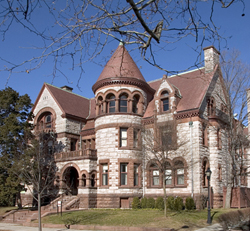The Henry and Elizabeth Pearce Estate
 Since March 1953, this charming estate has been the home of the Division of Applied Mathematics at Brown University. Henry Pearce hired skilled craftsmen from all over the world to create a stately interior complete with elaborate furnishings typical of the historic East Side estates of his day. Its fine interior exhibits ornate hand- tooled leather wall coverings, exquisitely carved woodwork, brass and crystal chandeliers, cast iron mantels, elaborate hardwood floors, unique hearths, and striking Tiffany stained glass windows. The iconic Pearce Estate was one of several very large homes on the East Side of Providence in the early years of the twentieth century. These opulent estates were manifestations of the wealth and social customs of a time when wealthy ladies entertained one another in the most extravagant settings possible. The Pearce Estate also possessed a very magnificent garden (where 180 George Street now stands) filled with rare and exotic trees and plants, which attracted the interest of botanists and nature lovers from around the world.
Since March 1953, this charming estate has been the home of the Division of Applied Mathematics at Brown University. Henry Pearce hired skilled craftsmen from all over the world to create a stately interior complete with elaborate furnishings typical of the historic East Side estates of his day. Its fine interior exhibits ornate hand- tooled leather wall coverings, exquisitely carved woodwork, brass and crystal chandeliers, cast iron mantels, elaborate hardwood floors, unique hearths, and striking Tiffany stained glass windows. The iconic Pearce Estate was one of several very large homes on the East Side of Providence in the early years of the twentieth century. These opulent estates were manifestations of the wealth and social customs of a time when wealthy ladies entertained one another in the most extravagant settings possible. The Pearce Estate also possessed a very magnificent garden (where 180 George Street now stands) filled with rare and exotic trees and plants, which attracted the interest of botanists and nature lovers from around the world.
The fortress-like, sprawling house is surely the most important example of a stone Richardsonian Romanesque style dwelling remaining in Providence. It is three stories high, made of rough ashlar granite walls with brownstone trim around irregularly placed windows. On the southwest corner there is a conservatory. The entrance has a large front porch. The equally fine carriage house stands at 21 Manning Street.
Early History
According to records kept by the R. I. Historic Preservation Society, when the Pearce family no longer lived in the estate it was eventually purchased by the Roman Catholic Diocese of Providence, and existed as a convent for nuns serving the needs of Saint Joseph’s Parish on Hope Street during the years 1923-1952. In 1923 the carriage house was purchased by Brown University, and nearly three decades later, the main house was purchased in 1952. In 1953, it became the home of the Division of Applied Mathematics.